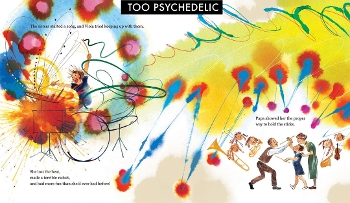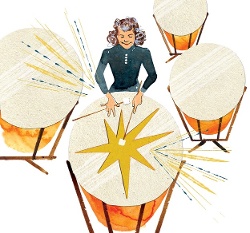Five questions for Dean Robbins and Susanna Chapman
The picture-book biography The Fastest Drummer: Clap Your Hands for Viola Smith! (Candlewick, 6–9 years) introduces young readers to a passionate musician whose long career also included influential advocacy for women in music.
The picture-book biography The Fastest Drummer: Clap Your Hands for Viola Smith! (Candlewick, 6–9 years) introduces young readers to a passionate musician whose long career also included influential advocacy for women in music. For books that sing a similar tune, see the “Express yourself” section of this issue of Notes from the Horn Book and the “Music appreciation” section from the October 2022 issue. See also our Women’s History Month tag and Women’s History Month 2024 coverage.
 1. Dean, how did you first learn about Viola Smith, and what drew you to write a picture-book biography about her?
1. Dean, how did you first learn about Viola Smith, and what drew you to write a picture-book biography about her?
Dean Robbins: Smith is a folk hero in Wisconsin where I live. A museum near her small hometown showcases photos and memorabilia, and she’s remembered for performing at vaudeville theaters around the state as an accomplished teenage drummer. But it wasn’t until I learned about Viola’s national significance that I had the idea of writing a picture-book biography. When she reached adulthood in the 1930s, women instrumentalists were viewed as inferior to men, and playing the drums was considered particularly “unladylike.” Against all odds, Smith boldly asserted herself in the male-dominated music industry, starting her own jazz orchestra and gaining fame as “the fastest girl drummer in the world.” Then she took up the cause of helping other women musicians by publishing an influential 1942 article in DownBeat Magazine called “Give Girl Musicians a Break!” From a young age, Smith was determined to pursue her passion, leap over obstacles, and open doors for others. I can’t imagine a more inspiring story for children.
2. Susanna, how did you figure out your unique way of “visualizing” sound?
Susanna Chapman: My first mistake was assuming that contrasting splats and bursts of colors would communicate percussion. Instead it looked psychedelic — oops! (If anyone needs an illustrator for Jefferson Airplane…I am ready to go.) I knew I had to do more listening to big band music and experimenting. Eventually I started cutting paper to punctuate melodic swirls and felt that expressed the physical presence of drums well. Too much paper weighed down the energy, and color schemes appropriate to Viola Smith’s musical era (1920s on) were important.



3. If readers are interested in exploring Smith’s music, where would you recommend they start?
DR: Start with the YouTube video “Frances Carroll & Her Coquettes Featuring Drummer Viola Smith.” When Smith takes her solo around the three-minute mark, it will become clear why this astonishing clip has received more than a million views. Viola hunches over an innovative twelve-piece drum kit of her own design with two tom-toms suspended at shoulder height. She beats out rhythms with abandon while windmilling her arms. To cap off the speed-demon display, she leaps to her feet and joyously raises her drumsticks to the sky. It’s no wonder Smith impressed the greatest drummers of her time, performed with jazz legends, and made the cover of Billboard magazine in 1940. She was, simply, a marvel.
4. What’s the most surprising thing you learned about this unsung (s)hero in your research?
DR: Smith is best known for her work as a jazz drummer in the 1930s and ’40s, but I learned that she never stopped crossing boundaries. After making her reputation in jazz, she attended The Juilliard School of Music to study timpani and played classical music with the National Symphony Orchestra. She also conquered Broadway as an onstage drummer in the original production of Cabaret. Viola continued to push the limits by expanding her twelve-piece drum kit to an even more spectacular seventeen pieces, and then by performing past the age of 100. Quite a set of accomplishments for a small-town dreamer who insisted on mastering an instrument deemed unsuitable for girls.


SC: Viola Smith attributed her long life (107 years!) to her aerobic drum playing, whether in big bands or with classical timpani. I admire anyone whose passion keeps their heart beating as they open doors for others. And she had so much fun! What a queen. I also deeply admire her seminal “Give Girl Musicians a Break!” article. Her writing reminded me that occasionally we do need to put down our drumsticks and use our words to effect change.
 5. What role does music play in your lives?
5. What role does music play in your lives?
DR: I took up the trumpet as a boy, fell hard for jazz, and spent years playing in bands. Then I combined my love of music and my love of writing to work as a jazz critic for newspapers, magazines, and radio. For more than two decades, I also helped organize a jazz festival in my hometown of Madison, Wisconsin. Given my interest in music history, I treasure a story Viola Smith once told about coming to Madison as a girl, probably in the 1920s. She sat on the steps of the Wisconsin State Capitol building and practiced her drumming with a Black male percussionist while a crowd gathered to watch them. White and Black, female and male — in an age of sexism and segregation, Viola was fiercely dedicated to breaking barriers.
SC: Music is such an exciting part of being human. I’ve never once seen my cats tap their little toes along with any song! I enjoy energetic music like Viola Smith’s drumming to dance with, and I also love music to be sad with, angry with, joyful with, calm with. Music expands my experience of life. (Disclaimer: I have heard that cats feel soothed by SOME music-ish sounds, and I’m trying to figure out if that might be true for my cats.)


From the February 2024 issue of Notes from the Horn Book.
RELATED
ALREADY A SUBSCRIBER? LOG IN
We are currently offering this content for free. Sign up now to activate your personal profile, where you can save articles for future viewing.







Add Comment :-
Comment Policy:
Comment should not be empty !!!